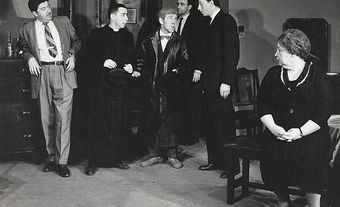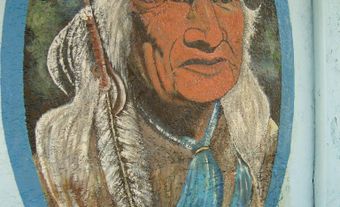Tanguay, Eva
Eva Tanguay, vaudeville actress (b at Marbleton/Lime Ridge near Sherbrooke, Qué 1 August 1878; d at Los Angeles, USA 11 January 1947). Known as "The Girl Who Made Vaudeville Famous," Tanguay moved as a child to Massachusetts with her parents - her French father and her French-Canadian mother. There she exhibited an early interest in the stage. She toured for five years as a child actress in Little Lord Fauntleroy before taking small roles in now-forgotten melodramas like The Engineer (1895) and Who is Who? (1899).
In 1901 Tanguay was featured as a singing and dancing comedienne in My Lady, at Oscar Hammerstein's Victoria Theatre in New York. Soon she had her own Eva Tanguay Comedy Company and was starring in The Office Boy (1903), The Sambo Girl (1904) and A Good Fellow (1906). In The Chaperones (1903) she created a sensation singing "I Don't Care," the song that became her signature tune. Absorbing the new century's feminist aspirations, she developed a vaudeville act in 1907 with an uninhibited persona to match the sexual freedom implied by her theme song. Twice daily her energetic and provocative routine brought down the house. Always introduced by trombones, the "electrified hoyden" gyrated around the stage in a frenzy, earning epithets like "The Queen of Perpetual Motion,""The Little Cyclone On Legs" and "The Female Jolson." She clowned and laughed in costumes made of feathers, dollar bills - even memo pads and pencils. Her titillating songs mocked Victorian conventions: "I Want Someone To Go Wild With Me, ""Go As Far As You Like "and "It's All Been Done Before, But Not the Way I Do It."
Tanguay's salary rose from $250 to $3500 a week. For 25 years she was hailed as "Vaudeville's Greatest Box Office Attraction." She toured in Canada and the USA, eventually defying the booking monopolies by touring independently. Tempestuous both onstage and off, she is reputed to have once thrown a stagehand down a flight of stairs for blocking her curtain call and to have sliced up a fire curtain when her billing wasn't satisfactory. She kept her name in the papers by taking champagne baths before performances, riding in hot air balloons and posing with tigers. In 1908 Tanguay incorporated the Salomé dance craze into her act and gave a press conference to publicize her costume. Opening her clenched fist, she revealed a couple of beads and a piece of green gauze. One sly reviewer noted that her "costume can hardly be described at length."
Her roadshow act was filmed in 1908 in an early attempt at sound screening. She was a guest artist in the Ziegfeld Follies of 1909 and made a silent movie in 1916 (Wild Girl). According to the "Roll Back the Years" discography, her version of "I Don't Care" was recorded about 1922. In 1918, at the end of World War I, she sang "La Marseillaise" in French, on her knees, dressed in tiny flags. Critics were at a loss to explain her appeal. She wasn't beautiful. Her big, brassy, singing voice was variously described as "The wail of a prehistoric diplodocus" or "having no more music than a buzz saw," but her assault-and-battery humour and youthful vitality kept her before the public well into her 50s.
Tanguay's trademark was to pay for things with thousand-dollar bills, but in the stock-market crash of 1929 she lost $2 million. With the imminent demise of vaudeville, she was reduced in 1931 to playing four and five times a day in small cabarets. After dabbling in real estate in Los Angeles, she died there at the age of 68, in relative obscurity and virtually blind from cataracts.
Mitzi Gaynor starred in the 1952 film version of her life, The I Don't Care Girl.

 Share on Facebook
Share on Facebook Share on X
Share on X Share by Email
Share by Email Share on Google Classroom
Share on Google Classroom


